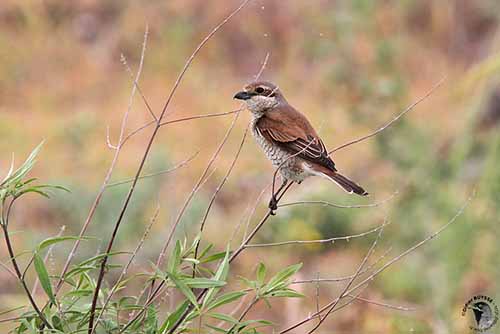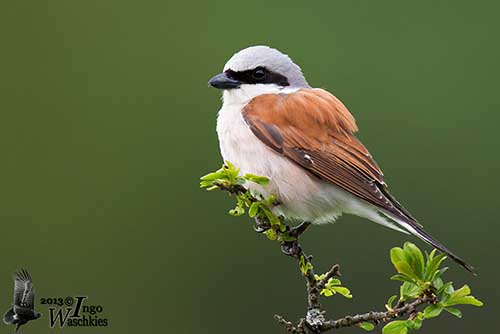
Fr: Pie-grièche écorcheur
Ang: Red-backed Shrike
All: Neuntöter
Esp: Alcaudón Dorsirrojo
Ita: Averla piccola
Nd: Grauwe Klauwier
Sd: Törnskata
Photographers:
John Anderson
John Anderson Photo Galleries
José Luis Beamonte
Pájaros de España
Didier Buysse
Vision d’Oiseaux
Otto Plantema
Trips around the world
Ingo Waschkies
Bird Photography
Text by Nicole Bouglouan
Sources :
HANDBOOK OF THE BIRDS OF THE WORLD Vol 13 by Josep del Hoyo-Andrew Elliot-Jordi Sargatal - Lynx Edicions – ISBN: 9788496553453
BIRDS OF THE MIDDLE EAST by R.F. Porter, S. Christensen, P Schiermacker-Ansen C.Helm - ISBN: 0713670169
ENCYCLOPEDIE DES OISEAUX DE FRANCE ET D’EUROPE – de Peter Hayman et Rob Hume - Flammarion – ISBN : 2082009920
L’ENCYCLOPEDIE MONDIALE DES OISEAUX - Dr Christopher M. Perrins - BORDAS - ISBN: 2040185607
THE COMPLETE BOOK OF BRITISH BIRDS – Written by “Royal Society for the Protection of Birds” experts - Préface de Magnus Magnusson - Michael Cady- Rob Hume Editors - ISBN: 0749509112
THE HANDBOOK OF BIRD IDENTIFICATION FOR EUROPE AND THE WESTERN PALEARCTIC by Mark Beaman, Steve Madge - C. Helm - ISBN: 0713639601
Birds of Britain - The Web Magazine for Birdwatchers
Pájaros de España (JL Beamonte)
Wikipedia, the free encyclopaedia
Home page
Page Passeriformes Order
Red-backed Shrike
Lanius collurio
Passeriformes Order – Laniidae Family
INTRODUCTION:
The Red-backed Shrike was formerly called « butcher bird », and this name comes from the feeding behaviour of this bird which stores and spikes the recently caught preys on thorny plants or even on barbed wires.
This bird has hooked, hawk-like bill, and like a hawk, it sometimes carries preys in its feet.
The Red-backed Shrike breeds in open woodland with dense thorny cover providing hunting posts and thorny branches for impaling the food items (larders).
This species is migratory and winters in South Africa.
DESCRIPTION OF THE BIRD:
Biometrics:
Length: 17 cm
Weight: 23-24 g
The adult male has pale grey crown, nape, rump and uppertail-coverts, and chestnut mantle, back and scapulars. The upperwing is blackish with chestnut-edged feathers. There is sometimes a small, white wing patch at primaries’ bases.
The tail is black but the central pair of rectrices has white base, whereas the outer pairs show white outer webs. The black terminal bands on other tail feathers form an inverted T visible in flight.
On the underparts, chin and throat are white. Rest of underparts is pale salmon-pink. The undertail-coverts are white.

On the pale grey head, the lower forehead is black. We can see a conspicuous black eye mask from lores to rear of ear-coverts.
The hooked bill is black, with paler or bluish base outside the breeding season. The eyes are dark brown. Legs and feet are dark brown to black.
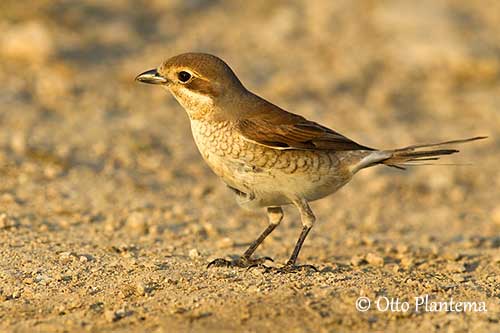
The female resembles male but she is paler and duller. On the head, lower forehead and supercilium are creamy-white, whereas ear-coverts are brown. Crown and upperparts are brown to greyish-brown. The nape is greyish but variable. Rump and uppertail-coverts are greyish. The tail is dark brown or slightly rufous with whitish edges and tip. On the upperwing, the fringes are paler and duller than in male.
The underparts are creamy-white with pale pinkish-buff wash on breast sides and flanks, vermiculated with blackish except on throat and undertail-coverts. Bill and legs are slightly paler than in male.
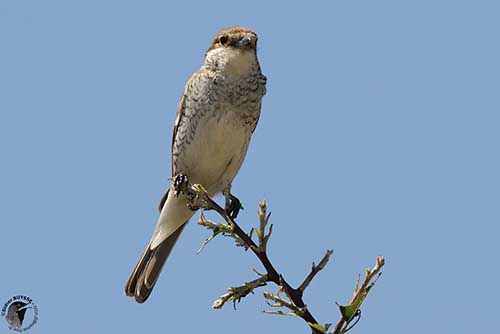
The juvenile resembles female with duller entire upperparts which are mostly rufous-brown to buffish-brown with heavy dark barring. The underparts are more heavily vermiculated. The bill has yellow base.
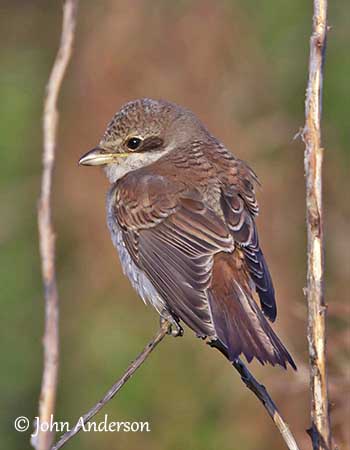
SUBSPECIES AND RANGE:
The Red-backed Shrike has three subspecies.
L.c. collurio (described above) breeds in Europe (except N, NW and SW) E to W Siberia, S to N Iberia, Sardinia, S Italy, Sicily, Balkans (S to Croatia), C Romania, Ukraine and plains of N Caucasus. It winters in S and E Africa.
L.c. kobylini breeds in Balkans (S from Bosnia) E to Crimea and Caucasus, S to Asia Minor, Cyprus and NW Iran. It winters in S and E Africa.
This race is duller than nominate, with greyer upper mantle.
L.c. pallidifrons breeds in W and WC Siberia (E to NW Altai). It winters in S and E Africa.
This race has paler crown and hindneck than nominate.
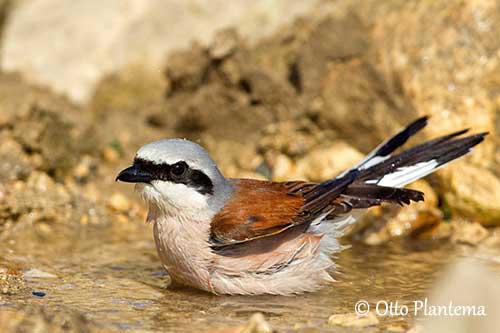
HABITAT:
The Red-backed Shrike breeds in a variety of habitats including woodland edges and clearings, open country with scattered trees and bushes, scrubby habitat and heathland, bushy areas with thorny scrub, orchards and olive groves.
It needs hunting posts allowing good view over areas of short grass, heath or bare ground where small preys are abundant.
The species can be seen in mountainous areas in some parts of the range, up to 1000/2000 metres of elevation.
On the South African wintering grounds, the Red-backed Shrike frequents fairly similar habitat types. It can be seen in savanna, grassland and Karoo (semi-desert natural region).
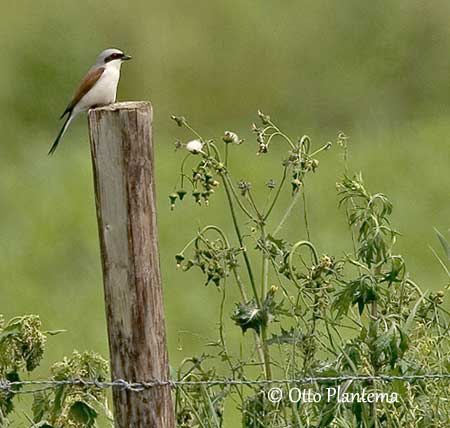
CALLS AND SONGS: SOUNDS BY XENO-CANTO
The Red-backed Shrike’s call is a hard, slurred “shack” or “shak-shak”, and harsh “churruk churruk”. The contact call is a shorter “tek-tek” becoming a series of hoarse hard notes in alarm “keck-keck-keck”.
The warbling song is quiet and musical, and includes mimicry of other small birds’ songs and calls.
BEHAVIOUR IN THE WILD:
The Red-backed Shrike forages in habitats where large insects, small reptiles and rodents are abundant. Its diet includes mainly insects (Coleoptera, Orthoptera and Hymenoptera), and various other invertebrates. Small mammals (voles), birds and reptiles are taken too. According to the season, it also feeds on berries in late summer and autumn.
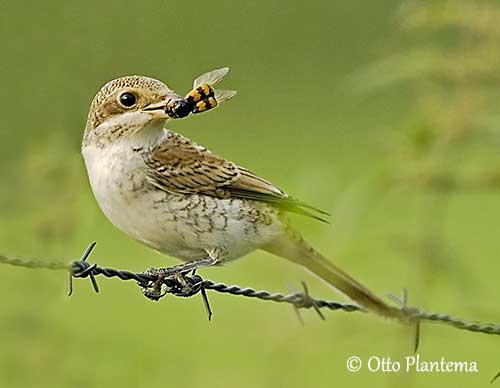
The Red-backed Shrike hunts from prominent perches to spot easily the passing preys. It swiftly drops onto the prey on the ground, but it also chases flying insects on the wing. The larger preys such as small birds, mammals, lizards and frogs are killed with a sharp peck to the back of the head.
Then, the prey items are usually impaled on thorns at traditional sites (larders) within the territory. It is easier for the bird to eat the larger preys as they are impaled, but it may also hold them in one foot.
This behaviour could play a role in mate attraction, as females may choose males able to bring abundant food to the chicks. A well-stored larder allows the pair to have better breeding success.
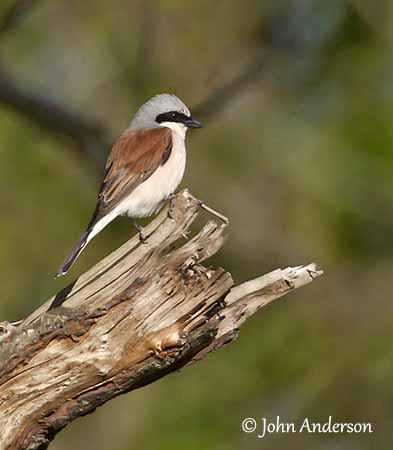
The Red-backed Shrike is usually monogamous, although some cases of polygyny have been recorded in Poland and Sweden. However, the male may become aggressive during the fertile period of the female, and another male approaching a mated female can be weakly or fiercely attacked. Interactions are usually stronger during both nest-building and laying periods.
In order to drive away other males and to attract females, the male may perform a peculiar display in which it mimics the action of impaling a prey. Another display follows, in which the male feeds the female while performing a bowing dance. The female accepts a prey from the male when she is ready for the copulation. She holds the prey while lowering her upper body.
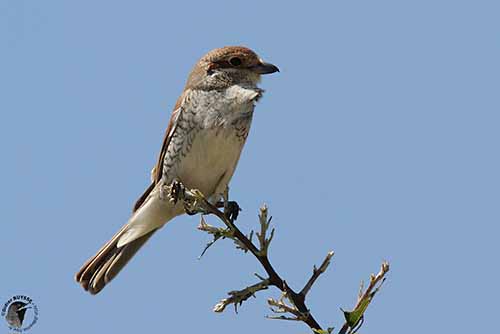
The boundaries of the territory are established mainly by songs from perches. Some fights may occur with loud rasping calls, foot-grappling and sometimes pecking.
The pair formation occurs mostly in breeding territories, or occasionally during spring stopovers.
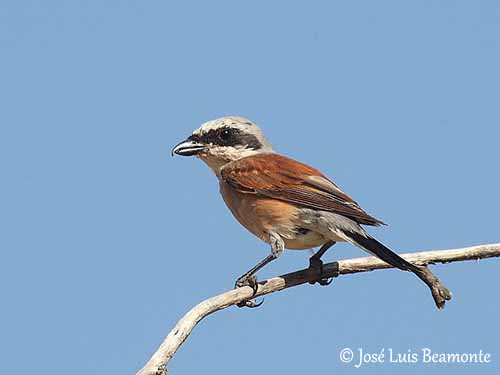
The Red-backed Shrike is migratory and is a nocturnal migrant. It leaves the breeding grounds between late July and second half August/early September. The birds move SE or SSE towards E Mediterranean. The first arrivals in extreme S of the wintering areas occur in late October.
The return to the breeding grounds starts in second half March until mid-April.
The Red-backed Shrikes are heavily preyed upon during their migration, due to their straight, slow flight. While foraging, the birds glide and hover along hedges.
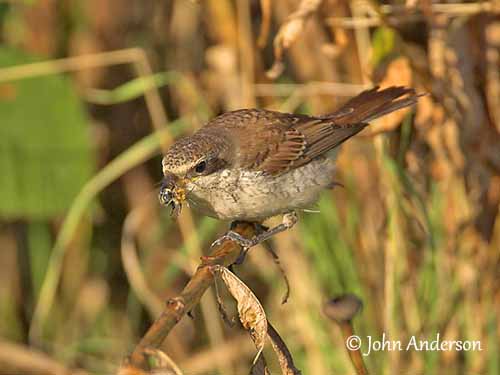
REPRODUCTION OF THIS SPECIES:
The Red-backed Shrike breeds in spring, with the laying between May and July according to the range. This species usually produces a single brood per year, rarely two.
It nests in dense bush or small tree. The nest is cup-shaped with loose foundation of green plant stems, roots, grass, lichen and other plant material. The inner cup is lined with grass, moss and fur. It is usually placed low down in dense thorny bushes.
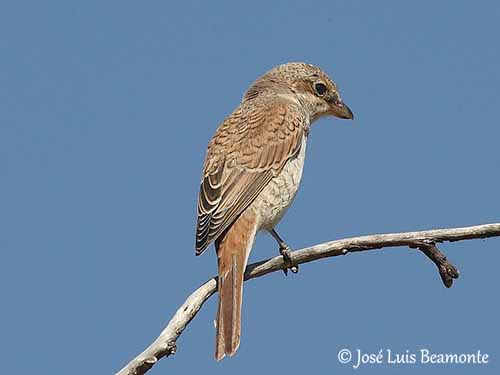
The female lays 4-6 very variable eggs, usually pale with brown markings. The clutch is replaced if lost. The female incubates alone during about two weeks. The male rarely assists. The chicks are naked at hatching. They are brooded by the female for the first week and fed by the male. Then, both parents feed them. The young fledge 14-16 days after hatching but in bad weather, mostly up to 18-20 days.
The young are able to catch insects about two weeks after leaving the nest, but they are independent only 20 days later.
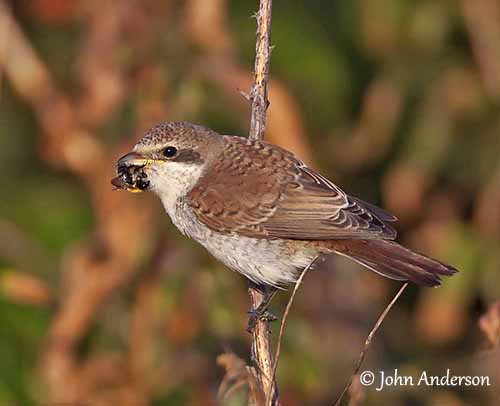
PROTECTION / THREATS / STATUS:
The Red-backed Shrike has wide range in which it is locally common, uncommon or rare. This species is more or less extinct in UK where it was formerly locally common. However, it recently bred in N Scotland (Shetland).
Most eastern populations remained stable while declines occurred in 1990/2000 in several countries. The European population has a moderate decline between 1970 and 1990.
Declines are mainly due to habitat loss and fragmentation of this habitat after afforestation and agriculture expansion, involving the use of pesticides and loss of food resources.
The European breeding population was estimated to number 6,300,000/13,000,000 breeding pairs or 18,900,000/39,000,000 individuals. As Europe forms 25-49% of the global range, a preliminary estimate of the global population size is 38,600,000/156,000,000 individuals.
But currently, the Red-backed Shrike is evaluated as least Concern.
